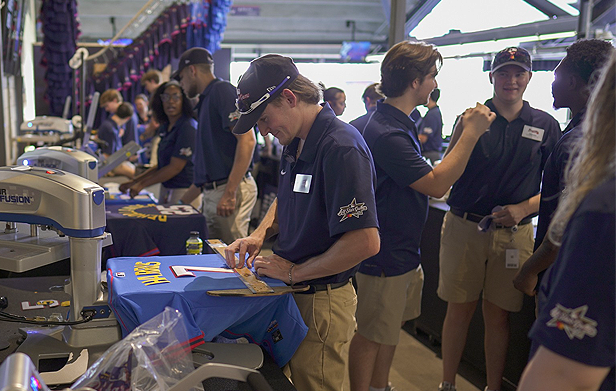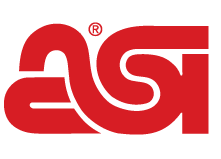August 08, 2025
Stahls’ MLB All-Star Weekend Experience Shows Power of Print on Demand
Stahls’ partnered with Fanatics and the Atlanta Braves for a live retail pop-up where fans could buy custom jerseys that were decorated on the spot.
Key Takeaways
• Stahls’ (asi/88984) partnered with Fanatics and the Atlanta Braves to offer fans personalized jerseys at the MLB All-Star Game using onsite heat press technology, creating memorable, one-of-a-kind souvenirs.
• The team used digital mock-ups and preset kits to streamline jersey customization, completing each in five to seven minutes while managing inventory based on historical demand data.
• The success of this campaign highlights how personalized, live customization can drive engagement and revenue, and can be adapted for smaller events beyond professional sports.
Going to the MLB All-Star Game and Home Run Derby are lifelong memories for baseball fans and can even be a once-in-a-lifetime experience. To make that experience even more special and create a one-of-a-kind souvenir, Stahls’ (asi/88984) partnered with Fanatics and the hosting Atlanta Braves to custom print jerseys for fans inside Truist Park.

Stahls’ (asi/88984) partnered with Fanatics and the Atlanta Braves for a print-on-demand experience at the MLB All-Star Game and Home Run Derby.
To make this happen, Stahls’ had its Hotronix Air Fusion IQ and Dual Air Fusion IQ heat presses onsite, and the partnership with Fanatics allowed them access to official team logos, fonts, jersey sizes and unique colorways.
“It’s a multistep process that ensures everything complies with brand guidelines and is ready for customization at the event,” Carl Agosta, vice president of strategic account sales and licensing for Stahls’, told ASI Media. “Having that trusted relationship with Fanatics helps streamline what could otherwise be a very complicated process.”
Kia Frank, product manager for Stahls’ Fulfill Engine, said they used their Fan Edition platform to mock up digital designs for the jerseys, using PNG files provided by Fanatics for patches, and created custom designs for numbers and letters.
Each jersey had three decoration areas: a front number, a sleeve logo, and a back name and number with an arched layout. The print-on-demand team used both loose letters and preset player kits.
“From start to finish, each jersey took between five to seven minutes to complete, depending on the operator,” Frank said. “This includes picking the jersey, matching the correct patch, selecting letters and numbers, and pressing in all three locations.”
Managing Stock
With so many fans flocking to the ballpark, all wanting different team designs for their custom souvenir, the team had to have all the possible scenarios in mind and make sure they had the right components on hand.
This required using previous demand research.
“Our partner, the Atlanta Braves, purchased all of the blank jerseys in advance,” Agosta said. “They based their order on historical data from previous MLB events.”
The nature of the All-Star Game, where variables like the roster weren’t set until the 11th hour, meant the team had to be nimble and get by with minimal advance prep.

The team used a mix of preset names and loose lettering for custom jerseys.
“It’s important to note the jerseys must be brought in blank, since final team rosters aren’t officially announced until the week before the game,” Agosta said. “In total, about 5,000 blank jerseys were brought in to be decorated for players, fans and key sponsors.”
Demand for On-Demand Printing
There are plenty of places where baseball fans can get souvenirs at the ballpark. But Stahls’ and Fanatics created pieces unique to each customer, which makes for something they’ll hold in higher regard because it feels tailor-made for them. This is a lesson distributors can take away, even if they aren’t in the sports world. Creating a product that the end-user feels is uniquely made to their preferences increases the chances they’ll keep and cherish it.
“Whether it’s a major event like the All-Star Game or a regular season matchup, fans love personalized gear,” Agosta said. “It’s an experience they can’t get anywhere else.”
The print-on-demand nature of the campaign also limits potential for deadstock and waste, Agosta added – something that appeals to smaller decorators and distributors getting into product decoration and printing.
“From a retailer’s standpoint,” he said, “It reduces the risk of carrying pre-decorated jerseys that might not sell, and it’s consistently one of the top revenue-drivers.”
Also, Agosta said, the very nature of an in-person decoration campaign is a natural attraction. People can see the energy and want to check it out. Once they’re there, they see the custom product and want one for themselves, and they’re able to watch their product go from start to finish.
“It becomes a live event within the event,” Agosta said. “People stop to watch, engage and even wait in line just to be a part of it. It’s an incredibly powerful form of experiential retail.”
Scaling to Size
Major League Baseball, specifically the All-Star Game, is a high point for any distributor in the sports space. But, this campaign can be scaled down to even a tee-ball league. Big league ideas can be applied to Little League customers.
“Look at youth and travel sports events that happen every weekend,” Agosta said. “You’ll often find customization tents where players and fans can pick apparel and personalize it on the spot using heat transfer materials.”
This idea can also exist outside of the sports world: Any event or organization where a logo, name or commemorative date can be applied to a product could work for an experiential campaign like this.
“With the right heat press, transfer materials and a smart inventory system, any printer or distributor can build a similar experience,” Agosta said. “You don’t need to be at an MLB stadium to create something exciting and profitable.”
